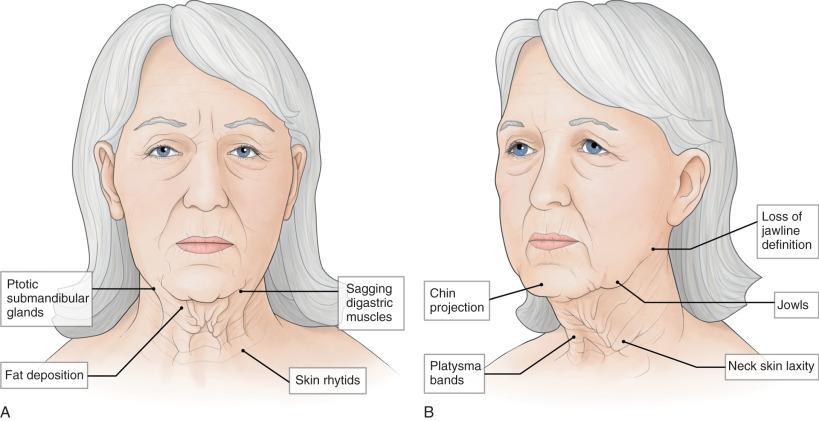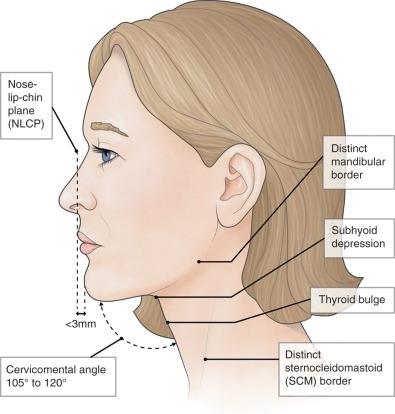Physical Address
304 North Cardinal St.
Dorchester Center, MA 02124
Neck shape is determined by the following:
Mandible anatomy—chin hypoplasia
Skin turgor, texture, tone
Fat deposition location and volume
Platysma anatomy and physiology
Submandibular gland size and position
Digastric muscle size
Hyoid position
Thyroid cartilage prominence

Neck contours are determined by the interplay of multiple factors. Because the face and neck are visualized as one region of the human form, it is important to understand the importance of maintaining a balanced appearance. In a study by Ellenbogen and Karlin, attractive features of the youthful neck were described ( Fig. 12.2 ) as follows:
Cervicomental angle, 105 to 120 degrees; submental-sternocleidomastoid angle, 90 degrees
Visible border of sternocleidomastoid muscle
Visible thyroid cartilage
Subhyoid depression
Well-defined mandibular border

Patients are distressed by a lack or loss of neck contours that is genetically inherited or acquired through the aging process. Sculpted neck contours relay an image of youth and fitness, whereas poorly defined necklines make a person appear older and less fit or overweight. These perceptions commonly affect how we view ourselves or how we view others. Understanding each patient's concerns, goals, and desires is paramount when determining the optimal approach to rejuvenate and refine the neck. Involving the patient in the decision-making process by presenting various options allows formulating a realistic treatment plan that will address the specific problem areas. It also creates a platform to present realistic expectations. The ability to review similar patients with similar neck problems—showing before and after images—is one of the most effective ways to educate potential patients regarding what to expect. Skin quality and texture are also important factors. Patients do not like the wrinkles that develop in the neck skin as a result of sun exposure and aging. Patients are also concerned about the unattractive appearance of features such as platysma banding, which occurs with movement.
A complete medical history should be taken to determine suitability for any treatment. The presence of congenital and autoimmune disorders of the skin needs to be researched to determine if surgical or other treatment modalities are safe, with predictable outcomes. A history of trauma, malignancy, and/or prior procedures that may have altered the neck anatomy and physiology are important to discuss. Determining the patient's impression of prior surgical procedures and their success or failure will give the surgeon a great deal of important information regarding how the patient will perceive the outcome determined by a recommended treatment plan. Risk factors such as prior complications, poor wound healing, excessive scarring, and a history of smoking need to be identified and considered. Most importantly, a thorough understanding of the patient's concerns needs to be coupled with a viable treatment plan that will deliver results to satisfy the patient. The success of satisfying a patient is based on the ability to communicate realistic expectations of the outcome.
It is important to understand the various anatomic features that define what is considered attractive. Surgically altering the neck without attention to the face may draw attention because of the loss of harmony.
Visual inspection of the front of the neck and the lateral view is helpful to identify platysma bands and assess the cervicomental angle. Assessing the bony structure of the mandible is the initial step in evaluation. The width of the mandible and the lateral and anterior projections of the chin must be considered. Genetically, a person may have an obtuse angle that results from a low position of the hyoid, which may give the appearance of excessive submental fat. Thyroid cartilage position and prominence are noted and are important to consider in female patients for whom a platysma myotomy is planned. In these cases, it is recommended to keep the myotomy at least 2 cm below the thyroid cartilage. The slight visibility and prominence of the thyroid cartilage are considered attractive in females, and the unmasking of a prominent thyroid cartilage is not desirable. When evaluating the neck, it is important to point out findings to the patient so that she or he may understand that certain features may become more apparent following fat removal and/or modification of the deeper structures of the neck. In addition, large submandibular glands, fat deposits, and prominent digastric muscles need to be assessed and treated, as indicated, to improve outcomes. Age-related changes that need to be addressed include increased fat deposits, visible platysma bands at rest or with movement, ptosis of the submandibular glands, and skin laxity. All these factors contribute to the loss of youthful and attractive neck contours. During the consultation, all these anatomic features need to be addressed and discussed with the patient.
Become a Clinical Tree membership for Full access and enjoy Unlimited articles
If you are a member. Log in here